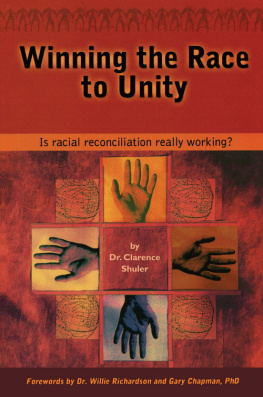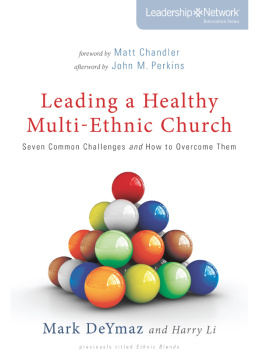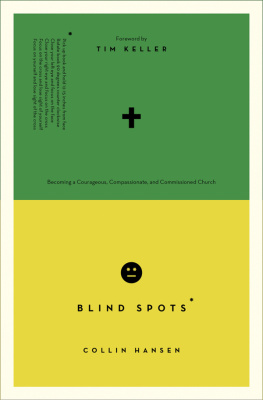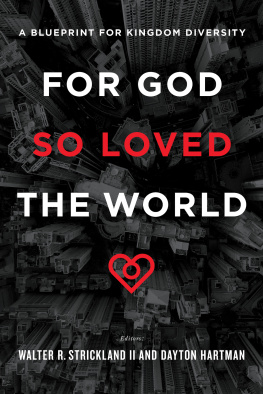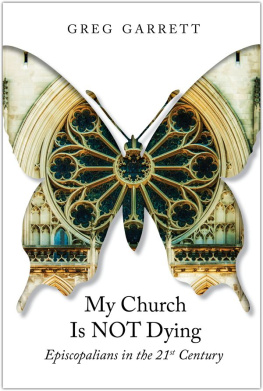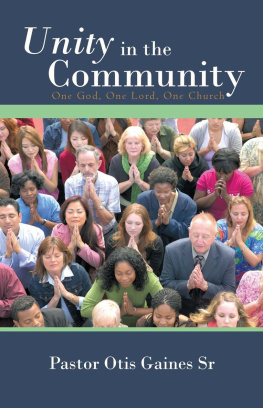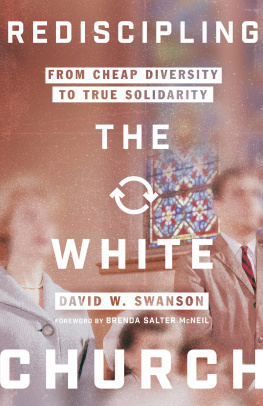THE BEAUTIFUL
COMMUNITY
UNITY, DIVERSITY,
AND THE CHURCH
AT ITS BEST
IRWYN L. INCE JR.
FOREWORD BY TIMOTHY KELLER

A sense of personal beauty comes,
I believe, only in the generous, self-giving gaze,
the noticing regard of another person.
ESTHER LIGHTCAP MEEK

FOR IRWYN L. E. INCE (19262009),
from whom I received a sense
of personal beauty before I knew what that was.
I never had to look for eyes to affirm my beauty and dignity
because his gaze always spoke a message of generosity,
selfless giving, and love matched only by
the actions that confirmed the message.

Contents
The Holy and Beautiful Habitation
Our Relational God
The Beauty of the Lord
Our God Is Beautiful Community
The Perfection of Beauty
Knowing Ourselves
A Crown of Beauty in the Hand of the Lord
Beautiful Community as God's Image
Your Beautiful Crown Has Come Down from Your
Head Ghettoization of Humanity
I Will Beautify My Beautiful House
Identity and Formation
Put On Your Beautiful Garments
Culture and Community
How Beautiful Are the Feet
Gospel MessageDevote to the Doctrine
The Beauty of Holiness
Probe the Preferences and Count the Cost
Our Holy and Beautiful House
Toast to the Truth
Timothy Keller
N early fifty years ago I enrolled at Gordon-Conwell Seminary. A small group of us single students, all of whom lived on campus, ate in the cafeteria three times a day and became something of an informal theological dinner club. Several of my most life-shaping friendships emerged from this group. The most significant one, of course, was my friendship with Kathy, my future wife.
But another was Elward Ellis, an African American student who went on to be a leader with InterVarsity Christian Fellowship and a Presbyterian minister. One day Kathy and I were with Elward and we said something about race that he corrected gently. We responded that we were indeed ignorant in this area and would be happy to listen to him. I remember that there was a twinkle in his eye when he said, Really? Are you really asking me to be truthful with you about the subject of race? Will you be willing to be instructed by me?
We may have swallowed hard when we said yes because we wondered if we were going to be scolded. But thats not what Elward did. Over the next couple of years, Elward simply paid us the compliment of speaking with candor. He laid out some basic ideas about race and race relations that we never forgot. I remember three particularly vividly.
One was that white folks did not have to be personally bigoted toward individuals of another race in order to support social, educational, judicial, and economic systems and customs that automatically privileged whites over others. This is more often recognized now, but at the time it was a completely new idea to us. Like most Americans, we thought that every persons condition was purely the result of their own choices, so that if you were poor it was mainly your fault. Elward showed us that this was simplistic to the point of being false.
Another was that the Euro-white culture is nearly invisible to white Christians. When you come to my church, he said, and you see how we worship and sing and preach, you think thats the black way. But when you look at your own church you just think thats the right way. He went on to explain that white Christians dont realize how much of what they say and do in church is not from the Bible but rather is shaped by cultural factors. As Irwyn says in this book, these are cultural preferences, not biblical principles, but white Christians tend to absolutize them in our minds. By making our cultural preferences normative for everyone, we not-so-subtly invite white people to come to our churches while inviting non-white people to stay away.
A third thing we learned was why white people are so unaware of these realities. Elward said, We [non-whites] have to know the white culture in order to survive. When we come into your workplaces and retail spaces and organizations, we have to learn how you regard time and use space, how you understand relationships between the individual and the group, how you think and solve problems, and express emotion and handle failures and judge status. But for you to function well in your society, you dont need to understand us or our culture and differences. In short, nearly every racial minority in the US understands Euro-white culture pretty well, but we whites are far more ignorant of how the cultures of others operate.
That means that in mixed race churches, the burden of relationship maintenance tends to fall disproportionately on racial minorities, even if they are well represented statistically. Elward once said to us, You can pick up the topic of race for an evening discussion and then the rest of your week you dont need to think about it. Race is an abstraction for yousomething out there. For meevery time I look in the mirror I think of race. We have to think about it all the time, but when we get into a church with white brothers and sisters and want to talk about it as much as we need to, you all quickly get tired of it.
These things and others that Elward told us have helped us enormously to understand race and so much of what goes on in the church. Wed never heard anything like them, and it was decades before we began to see them in print. Today there are more places for white evangelicals to hear and consider themand one of the best places is here in this book by Irwyn Ince.
Irwyn lays a solid theological foundation for the idea that the multiracial church is Gods will. He begins by looking at the doctrine of the Trinity itself, then expounds the judgment at Babel, its reversal at Pentecost, the growth of the multiracial churches in the book of Acts, and the final destinationthe church of every tongue, tribe, people, and nation in Revelation 7.
In particular, he examines how our Christian identity gives the basis for multiethnic fellowship. Biblical scholar Larry Hurtado described how the uniquely translocal and transethnic identity of being in Christ created the first multiethnic religion in history, because Christian conversion relativizes our cultural and social identities without effacing them. Irwyn backs up this claim extensively and shows how both individual and group identity formation bear on the development of racially and culturally diverse Christian churches and ministries.
After the doctrinal groundwork, Irwyn lucidly and candidly lays out so many of the dynamics of which Elward spoke to us long ago. He draws on recent scholarship to show how much racial exclusion is structuralrather than all due to personal, conscious racial animosityand is therefore hidden from whites. He makes visible the cultural preferences and ethnic identities that feel so primordial and absolute.


